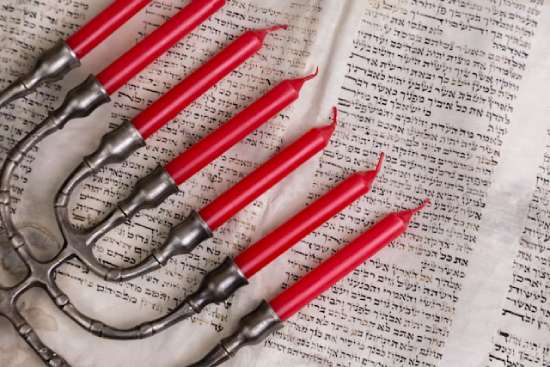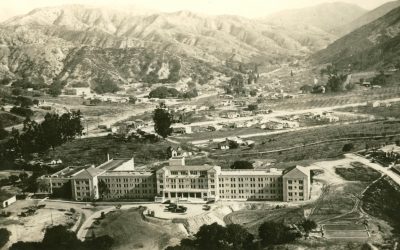Jesus’ Ministry in the Heavenly Sanctuary
What is Jesus Christ doing right now?
Seventh-day Adventists believe, according to the book of Hebrews, that Jesus is in the heavenly sanctuary—or temple—right now. He is our high priest, and His ministry in this role links His sacrificial death to the forgiveness of our sins and the cleansing of our hearts as we accept Him as our Savior.
And He is doing all of this to show us the compassionate and loving heart of God. Satan is our accuser (Revelation 12:10), but Jesus’ ministry in the heavenly sanctuary is God’s way of silencing those accusations and showing His fairness in forgiving us.
But to understand what all of this means, we need to get some background.
We’ll look at:
- What the Bible says about a literal heavenly sanctuary
- How the earthly sanctuary was a model of the heavenly sanctuary
- How the sanctuary relates to Christ’s ministry
- The Day of Atonement—the cleansing of the sanctuary
Adventists state their official belief on the heavenly sanctuary as follows:
“There is a sanctuary in heaven, the true tabernacle that the Lord set up and not humans.
In it Christ ministers on our behalf, making available to believers the benefits of His atoning sacrifice offered once and for all on the cross.
At His ascension, He was inaugurated as our great High Priest, and began His intercessory ministry, which was typified by the work of the high priest in the holy place of the earthly sanctuary.
In 1844, at the end of the prophetic period of 2300 days, He entered the second and last phase of His atoning ministry, which was typified by the work of the high priest in the most holy place of the earthly sanctuary.
It is a work of investigative judgment which is part of the ultimate disposition of all sin, typified by the cleansing of the ancient Hebrew sanctuary on the Day of Atonement. In that typical service the sanctuary was cleansed with the blood of animal sacrifices, but the heavenly things are purified with the perfect sacrifice of the blood of Jesus.
The investigative judgment reveals to heavenly intelligences who among the dead are asleep in Christ and therefore, in Him, are deemed worthy to have a part in the first resurrection. It also makes manifest who among the living are abiding in Christ, keeping the commandments of God and the faith of Jesus, and in Him, therefore, are ready for translation into His everlasting kingdom.
This judgment vindicates the justice of God in saving those who believe in Jesus. It declares that those who have remained loyal to God shall receive the kingdom. The completion of this ministry of Christ will mark the close of human probation before the Second Advent.”
Now let’s break this all down, starting with where we find these details in Scripture.
What the Bible says about a literal heavenly sanctuary

Photo by Diana Polekhina on Unsplash
The book of Hebrews mentions that Jesus is in a sanctuary in heaven right now.
It explains that Jesus is “seated at the right hand of the throne of the Majesty in the heavens, a Minister of the sanctuary and of the true tabernacle which the Lord erected, and not man” (Hebrews 8:1-2, NKJV).
From this verse, we learn that this heavenly temple was built by God Himself and not by any human being.
This original in heaven provided the template for the sanctuary that was built on earth, first mentioned in Exodus. This earthly sanctuary was described as a “copy and shadow of the heavenly things” (Hebrews 8:5, NKJV).
That’s why, when God told Moses how to make the earthly sanctuary and its furniture, He emphasized:
“Make them according to the pattern which was shown you on the mountain” (Exodus 25:40, NKJV).
This is the same sanctuary that John saw in vision when he recorded:
“Then the temple of God was opened in heaven, and the ark of His covenant was seen in His temple” (Revelation 11:19, NKJV).
As we will see, this heavenly sanctuary has furniture similar to the earthly one.
The earthly sanctuary was a model of the heavenly sanctuary
The Old Testament describes a sanctuary that was first built in the wilderness under Moses’ supervision. When God gave “the pattern of the tabernacle and the pattern of all its furnishings,” He meant that Moses would produce a replica of the one in heaven (Exodus 25:9, NKJV).
Moses built a sanctuary with two compartments—the Holy Place and the Most Holy Place. The structure was enclosed by a fence made of linen hangings, and this enclosure formed the outer court (Exodus 25:8; 27:9-15; Numbers 3).
Each of these compartments contains specific significance in the plan of salvation from sin.
Even the various offerings and feasts outlined in the Old Testament for the Israelites pointed to the life and ministry of Jesus for our salvation. The symbolism goes beyond Jesus’ earthly ministry and covers His work after His ascension to heaven.
That’s why when the Psalmist saw how God’s plan for the salvation of humanity is outlined in the sanctuary, he said:
“Your way, O God, is in the sanctuary” (Psalm 77:13, NKJV).
Let’s learn how we see God’s way through Christ’s ministry there.
How does the sanctuary relate to Christ’s ministry?
The earthly sanctuary was God’s way of helping the children of Israel know that He was present with them, giving them visible, tangible examples of how the issue of sin must be dealt with (Exodus 25:8). It helped them ultimately understand how Jesus was going to bring an end to sin through His sacrificial death, ascension to heaven, and His ministry in the heavenly sanctuary that will end with the Second Coming.
To deal with sin, two main services took place in the sanctuary (Hebrews 9:6-7):
- The daily services
- The yearly service (Day of Atonement)
The daily services involved the sacrificing of animals for the forgiveness of sins. The priests would make these sacrifices at the altar of burnt offering in the courtyard. Then they would carry them into the Holy Place of the sanctuary and sprinkle the blood there to symbolize the transfer of those sins from the individual to the sanctuary (Numbers 28:3-4; Leviticus 4:34).
The yearly service—known by the Jews as the Day of Atonement—was a way of “cleansing” the sanctuary from all the sins that had been symbolically transferred into the sanctuary.
During this service, the high priest entered the Most Holy Place of the sanctuary, which contained the ark of the covenant—a special item that represented the throne and presence of God and contained the Ten Commandments (Exodus 25:22; Hebrews 9:4).
The priest would sprinkle the blood there to symbolize God’s forgiveness of their sins.
When the ceremony was finished, the whole Israelite camp was considered ceremonially clean (Leviticus 16:29-34).
These acts were to symbolize what Jesus would do in His ministry.
The altar of burnt offering in the courtyard, where the animal sacrifices took place, represented Jesus Christ’s sacrificial death on our behalf (Exodus 27:1-8; Hebrews 10:12).
Then, He went into the Holy Place of the sanctuary to apply the blood of His sacrifice for our forgiveness. That began after His ascension to heaven.
Now, let’s look at what Jesus is actively doing in the Holy Place.
Jesus’ ministry in the heavenly sanctuary began at Pentecost

Photo by Skitterphoto
After His resurrection, Jesus appeared to His disciples for a period of 40 days. Then He ascended into heaven (Acts 1:3).
But before He left, He insisted they wait in Jerusalem until He had sent them the Holy Spirit to empower them to preach the Gospel to all the world (Luke 24:49; Acts 1:8, 9).
And ten days later, on the Day of Pentecost, the Holy Spirit was poured out on God’s people (Acts 2:1-4).
Now, Pentecost was the next Jewish feast after the Feast of Firstfruits, which was fulfilled at Christ’s resurrection.
It happened on the 50th day after the firstfruits of the harvest had been dedicated at the temple (Leviticus 23:15-17).
On this day, Jesus sent the Holy Spirit as promised. And this event was accompanied by “divided tongues, as of fire,” which “sat upon each of [the disciples]” (Acts 2:3, NKJV).
The exhibition of fire at this event is significant. It reminds us of a major milestone in the earthly sanctuary services recorded in the Old Testament.
When the priestly ministry first began, Aaron, who was the ordained priest, presented sacrifices on the altar.
And when he was done,
“Moses and Aaron went into the tabernacle of meeting, and came out and blessed the people. Then the glory of the Lord appeared to all the people, and fire came out from before the Lord and consumed the burnt offering and the fat on the altar” (Leviticus 9:22-24, NKJV).
Also, at the inauguration of Solomon’s temple, a sacrifice was offered. And as a symbol of God’s acceptance of the sacrifice, “fire came down from heaven and consumed the burnt offering and the sacrifices; and the glory of the Lord filled the temple” (2 Chronicles 7:1, NKJV).
The fact that the fire consumed the sacrifice signified that God accepted it. This was the case with Elijah’s and David’s sacrifices too (1 Chronicles 21:26; 1 Kings 18:38).
So, fire coming down from heaven signified three things:
- Acceptance of the sacrifice made at the altar
- Starting of the priestly ministry so the priest could enter the Holy Place
- Opening up the sanctuary as a place for ministry
And notice that the fire falls on the altar of sacrifice located in the outer court—which signifies the earth, where Jesus offered Himself as a sacrifice.
But we read that the “way into the holy places [was] not yet opened as long as the first section (the outer court) is still standing” (Hebrews 9:8-9, ESV).
This means the ministry in the Holy Place could not start until the ministry in the outer court had been finalized. And it was finalized when the sacrifice offered there was accepted.
The priest would enter the Holy Place and go out again to bless the people as Aaron did.
In explaining the events of Pentecost, Peter made it clear that Jesus had “received the promise of the Holy Spirit from the Father” and then poured it out to His followers on earth (Acts 2:33, NASB).
So Jesus went to the heavenly sanctuary after His ascension. And the acceptance of His sacrifice on the Cross was signified by the fire falling at Pentecost.
He entered into the Holy Place and blessed His people who were at the camp (on earth) with the outpouring of the Holy Spirit. This is key, because one of the priest’s first tasks in the sanctuary was to ensure continual light by adding oil to the lamps.
And guess what oil symbolizes!
The Holy Spirit (Zechariah 4:2-6; Acts 1:8).
That is why when John saw a vision of Jesus in heaven, He was walking amid the candlesticks to ensure they were lit to the end of ages (Revelation 1:13, 20).
And history shows that the witness of God’s true church could not be completely put out, even in the Dark Ages.
The Holy Place of the sanctuary also contained a table of bread, called showbread. The priests maintained the showbread in the sanctuary and changed it every Sabbath. Similarly, Jesus keeps His church fed by the Word of God. He Himself is the Word that became flesh (John 1:14), and at another time He also described Himself as “the bread of life” (John 6:35).
Again, history reveals that neither the Bible nor the Christians who upheld it were ever completely done away with, even though there were times and places throughout history when Christians were persecuted, access to the Scriptures was restricted1 or sparsely available, or a region’s religion or government discouraged (or even outlawed) owning a Bible.2
Jesus Himself stands to ensure His children can access it until the end.
Jesus is interceding for us in heaven—right now and continually
In the earthly sanctuary, the people would pray at the temple during the “hour of incense.” They’d pray outside while the priests were in the Holy Place, burning incense on the altar of incense. This prayer service did not end in the Old Testament times but continued even to the New Testament days (Luke 1:8-10).
Now in the heavenly sanctuary, Jesus “always lives to make intercession” for us as our high priest (Hebrews 7:25, NKJV).
He does this by mingling our imperfect prayers with His righteousness since He alone is “holy, harmless, undefiled, separate from sinners” (Hebrews 7:25-26, NKJV).
It’s only the righteousness of Christ that can make our prayers acceptable before God, just like only a special kind of incense was acceptable for the sanctuary service (Exodus 30:34-38).
As we pray, Jesus works to ensure our prayers are accepted and answered.
The book of Hebrews tells us that Jesus “is also able to save to the utmost those who come to God through Him, since He always lives to make intercession for them” (Hebrews 7:25, NKJV).
Therefore we can come with boldness to the throne of God and receive mercy and grace in our time of need (Hebrews 4:16).
But what about the yearly service in the sanctuary? How does that relate to Christ? Find out what the Day of Atonement was all about and how Jesus is fulfilling it today.
The Day of Atonement—the cleansing of the sanctuary
Leviticus 23 describes the Day of Atonement as “a holy convocation” (gathering) of the Israelites. On that day, the high priest performed a ceremony in which the sins that had been forgiven and transferred to the sanctuary all year long were removed. It was a cleansing of the sanctuary.
This ceremony is sometimes described as a Day of “At-one-ment”—meaning it was God’s way of making His people one with Him and reconciling them to Himself. It removed the barriers of sin that had separated the people from God.
That’s why, prior to this ceremony, all the people searched their hearts—called “afflicting their souls” in the Bible—to make sure they weren’t holding on to anything that could keep them from closeness with God.
The reason for this?
God loved them so much that He could not allow them to continue to live with sin. He knew that sin is messy and would eventually destroy them, so He provided a way for them to get rid of it from their lives.
If they chose not to accept that way, they were rejecting the only way out of the mess.
Because of the seriousness and importance of this ritual, the Israelites saw this day as a time of judgment.
How did this atonement happen?

Photo by Ray Aucott on Unsplash
While the people searched their hearts through prayer and fasting, the high priest would intercede for them by taking “two male goats for a sin offering” (Leviticus 16:5, ESV).
Then he would “cast lots over the two goats, one lot for the Lord and the other lot for Azazel [or scapegoat]” (Leviticus 16:8, ESV). Casting lots was similar to flipping a coin to make a decision.
The one for the Lord was sacrificed.
Its blood was used to cleanse the sanctuary and to “make atonement for the Holy Place, because of the uncleannesses of the people of Israel and because of their transgressions, all their sins” (Leviticus 16:16, ESV).
The high priest would carry the blood all the way into the Most Holy Place and sprinkle it before the ark of the covenant. The top of the ark of the covenant, representative of God’s throne, was called “the mercy seat” (Exodus 25:21). Here, the people received mercy even though they had broken the conditions of God’s covenant found in the Ten Commandments.
Then, the scapegoat was presented alive before the Lord.
With this one, the high priest would “lay both his hands” on its head and “confess over it all the iniquities of the people of Israel, and all their transgressions, all their sins” (Leviticus 16:21, ESV).
Then it would be sent away to the desert to bear all the sins of the people (Leviticus 16:21-22).
How is Jesus fulfilling the Day of Atonement?
In God’s plan to save us from sin, the Day of Atonement was fulfilled at the end of the 2300-day prophecy in 1844. This prophecy in Daniel 8:14 speaks of the cleansing of the sanctuary, which is a clear allusion to the Day of Atonement.
In 1844, Jesus entered the Most Holy Place in the heavenly sanctuary to begin a work of judgment that would cleanse the records in the Holy Place of heaven. He started going through the records of those who professed to follow Him. Adventists call it the Investigative Judgment (Daniel 7:9-10, 13-14; 1 Peter 4:7).
The Most Holy Place contains the Ten Commandments, which Jesus uses as the basis for the judgment. He looks at each individual’s life to see whether it reveals repentance that has led to a genuine change in that person’s life.
Jesus’ purpose in cleansing the heavenly sanctuary is to put an end to sin. With His intercessory ministry, repented sins have been transferred to the sanctuary. But now, He is going to completely cleanse it by cleansing the records (Jeremiah 17:1; Hebrews 9:23).
But in order for the records in heaven to be clean, He must also cleanse the lives of His people through His blood. He says that He is the one who “blots out your transgressions for My own sake; and I will not remember your sins” (Isaiah 43:25, NKJV).
Then those sins will finally be placed on Satan and eventually destroyed.
But Satan, who is also known as the “accuser of the brethren,” is quick to accuse us and say we’re not worthy of God’s gift (Revelation 12:10; Zechariah 3:1, NKJV).
He claims we’re unworthy of salvation due to our sinfulness and says God is unfair for forgiving us (Romans 3:23).
For this reason, Jesus acts as our advocate against Satan, in the presence of God and the universe (1 John 2:1), applying the benefits of His sacrificial death to all who claim them. He forgives our sins and places them in the sanctuary through His blood (Hebrews 9:12-26).
And this isn’t because God the Father doesn’t love us. After all, Jesus came to show us that the Father loves us just as much as He does (John 16:27).
But by advocating for us, Jesus is able to show that God is fair in forgiving our sins and giving us eternal life in heaven.
Only He can refute Satan’s arguments against the guilty human race (Jude 1:9; Zechariah 3:2). And He does this by showing that He paid the price for our release from guilt.
Thus, we are fairly redeemed from the clutch of Satan through Christ’s ministry for us.
This scene is vividly portrayed in the story of Joshua the priest, which is found in Zechariah 3:1-11.
The Investigative Judgment is going on now

Image by EKATERINA BOLOVTSOVA
As we’ve learned through this page, Jesus is going through our records in heaven. He is blotting out the sins of all those who have accepted His gift of salvation and cleansing.
Soon, His ministerial work will end. His ministry will come to a stop when our probation closes and He says:
“He who is unjust, let him be unjust still; he who is filthy, let him be filthy still; he who is righteous, let him be righteous still; he who is holy, let him be holy still” (Revelation 22:11, NKJV).
And since no one knows when this will happen, now is the time to turn to Him. The time to send our sins to Christ, who assures us of His forgiveness. Then, when He comes, we’ll be covered in His righteousness and be able to receive the blessings promised by God:
“If you will walk in My ways, and if you will keep My command, then you shall also judge My house, and likewise have charge of My courts; I will give you places to walk among these who stand here” (Zechariah 3:7, NKJV).
In a nutshell, we have seen that Jesus is currently ministering as our high priest in the heavenly sanctuary and revealing the heart of God the Father to us.
He advocates for us when Satan accuses us because of our sins. And thanks to His sacrificial death on the Cross, He redeems us from sin and the penalty of death by His own blood.
That is our only guarantee of eternal life at His Second Coming.
And even as Jesus cleanses the records during this time of Investigative Judgment, He also wants to cleanse our lives as we grow in Him.
- “Medieval Christendom,” Britannica. [↵]
- “Countries Where Christianity Is Illegal 2024,” World Population Review. [↵]
Questions about Adventists? Ask here!
Find answers to your questions about Seventh-day Adventists
More Answers
Why Many Seventh-day Adventists Choose a Vegetarian Diet
Why Many Seventh-day Adventists Choose a Vegetarian Diet?You may have an Adventist friend who is vegetarian, or maybe you’re attending a Seventh-day Adventist Church for the first time and notice the potluck doesn’t have any meat. This isn’t unusual in Adventism. In...
The Health Benefits of Fresh Air You Should Know About
The Health Benefits of Fresh Air You Should Know About“When you can’t breathe, nothing else matters,” the American Lung Association tells us. And while that’s true, the kind of air you’re breathing will determine the health benefits you experience. Breathing fresh...
What Do Seventh-day Adventists Choose to Eat?
What Do Seventh-day Adventists Choose to Eat?Food blogs overwhelm the internet; food fads are all the rage; and copycat and healthy versions of food are the subject of many a get-together. Eating—and eating the best way—is a big deal. And everybody has a different...
10 Incredible Ways Sunlight Can Improve Your Health
10 Incredible Ways Sunlight Can Improve Your HealthAre you concerned about sunlight’s negative effects? You might be the one who lathers on the sunscreen and covers up when you go outside. Or maybe you avoid being outside as much as possible. You might be surprised,...
Why Is Water So Important?
Why Is Water So Important?We all know that water is a substance we can’t live without. It quenches our thirst and keeps us hydrated on the inside. And it’s necessary for hygiene and cleansing on the outside too. But did you know that the cleansing properties of water...
Ellen White’s Writings and the Adventist Health Message
Seventh-day Adventists are known for their emphasis on healthy living. And Ellen G. White was a significant influence in the development of this priority and practice among Adventists.
Health Clinics
Ellen White and Adventist Healthcare—Ahead of Their Time Medical care in the mid-1800s was primitive, to say the least. Basic concepts we take for granted—such as proper handwashing or recognizing the dangers of bloodletting—were nonexistent. And doctors often had...
What Did Ellen White Teach about Vegetarianism?
What Did Ellen White Teach about Vegetarianism?One thing you might have heard about Seventh-day Adventists is their emphasis on a vegetarian lifestyle. If you’re wondering why that is, it goes back to our church’s humble beginnings: As Adventists studied the Bible,...
How Ellen White’s Teachings Can Improve Your Health
How Ellen White’s Teachings Can Improve Your Health Healthcare in the nineteenth century was said to leave “more disease than it took away” with its use of bloodletting and “medicines” like mercury and arsenic.1 As people questioned these methods, new approaches...
Change Your Perspective on Life with These 5 Mindsets
5 Biblical Mindsets to Change Your Life for the Better Sometimes, life is just plain hard. There’s no way around it. So would thinking about things differently really change anything? Our perspective on life, and everything it throws at us, affects more than we’re...
Bible Promises for When You’re Worried or Fearful
Bible Promises for When You’re Worried or Fearful The Bible is full of beautiful promises that can comfort us in a variety of situations. They can give us hope when we are hopeless, make us feel grateful for God’s love, and comfort us when we’re grieving or suffering....
12 Practical Ways to Overcome Worry
12 Practical Ways to Overcome Worry DISCLAIMER: This content is for informational purposes only. It does not constitute any professional medical advice and is not intended as a substitute for professional mental health therapy. It’s easy to get stuck in a cycle of...
How the Bible Talks About Worry, Fear, and Anxiety
How the Bible Talks About Worry, Fear, and Anxiety Worry and fear are the ingredients of anxiety. It’s easy to see how the world isn’t perfect—and the anticipation of a bad event or experience (that may or may not even happen) can end up draining the peace and...
How to Calm Anxious Thoughts, Using the Bible
How to Calm Anxious Thoughts, Using the Bible You were expecting a phone call from your daughter half an hour ago, and she still hasn’t called. She’s also not answering your calls. You feel your heart thumping as your thoughts race: What if she’s been in a car...
What You Should Know About the Adventist Health Studies
What You Should Know About the Adventist Health StudiesYou may have heard that Seventh-day Adventists care about health. But what you may not know is that Adventists have been the subjects of long-term research into lifestyle and health. Since 1958, researchers from...
Benefits of Sunlight
Yes, There Are Health Benefits of SunlightDespite the bad reputation it’s gotten, sunlight is generally associated with positivity, as shown by songs like “You Are My Sunshine,” or phrases that refer to delightful people as having a “sunny disposition.” There’s a...
Why Your Body Needs Rest for Optimal Health
Why Your Body Needs Rest for Optimal HealthStruggling to think straight? Wondering why you can’t remember that important tidbit you heard earlier today? Feeling like your emotions are about to explode? These are just some of the symptoms that can reveal your need for...
The Seventh-day Adventist Diet: One of Our Key Longevity Secrets
The Seventh-day Adventist Diet: One of Our Key Longevity SecretsOats, avocados, lentils, tofu—probably not what you first think of in a standard American diet. But if you show up at the home of an Adventist, chances are you may be served one of these staples. Out of a...
Why You Need Fresh Air
Why You Need Fresh Air“When you can’t breathe, nothing else matters,” the American Lung Association tells us. We couldn’t agree more! Breathing in clean air is an essential part of caring for our bodies, which God has given us. Together with other health principles,...
Sabbath Meal
Everything You Need to Know About Sabbath MealsFor Seventh-day Adventists, sharing a Sabbath meal with friends and family is one of the most special and memorable parts of the Sabbath. That’s why we want to share with you all about Sabbath meals and why they’re such a...
Adventists and Healthy Living
Adventists and Healthy LivingWhat’s the Adventist “Health Message” All About? One thing Seventh-day Adventists are known for is their emphasis on living healthy lives. Since our bodies are living temples of the Holy Spirit (1 Corinthians 6:19, 20), we strive to stay...
Water’s Importance—Physical Benefits and Spiritual Applications
Water’s Importance—Physical Benefits and Spiritual Applications We all know that water is a substance we can’t live without. Not only does it quench our thirst and keep us hydrated from the inside, but it’s necessary for hygiene and cleansing on the outside as well....
How Important is a “Day of Rest?”
How Important is a “Day of Rest?” Why God Created a Day for Downtime by Martin Casper Do you ever experience the feeling of complete overload? Do you feel like the only way you can get ahead is by slamming it 24/7? I hear these types of comments more and more...
7 Reasons Why a Day of Rest is Important
7 Reasons Why a Day of Rest is ImportantWe live in a fast-paced world. It seems as if success is measured in how much you can do in a short amount of time. (Extra points for the service or product that is available 24/7). The idea that we will be more successful if we...
How do Adventists choose what to eat?
How do Adventists choose what to eat?Every day, parents go through the ritual of getting their kids to eat what is healthy and good while trying to steer them away from what can hinder the growth of their developing bodies. Nutritionists work with their clients to...
How Can I Have a Better Marriage?
Is it possible to have a happy marriage?
Why are many Adventists Vegetarian?
Why are many Adventists Vegetarian?The diet intended for man is outlined in Genesis 1:29, “And God said, ‘See, I have given you every herb that yields seed which is on the face of all the earth, and every tree whose fruit yields seed; to you it shall be for food.’”...
Didn’t find your answer? Ask us!
We understand your concern of having questions but not knowing who to ask—we’ve felt it ourselves. When you’re ready to learn more about Adventists, send us a question! We know a thing or two about Adventists.




















